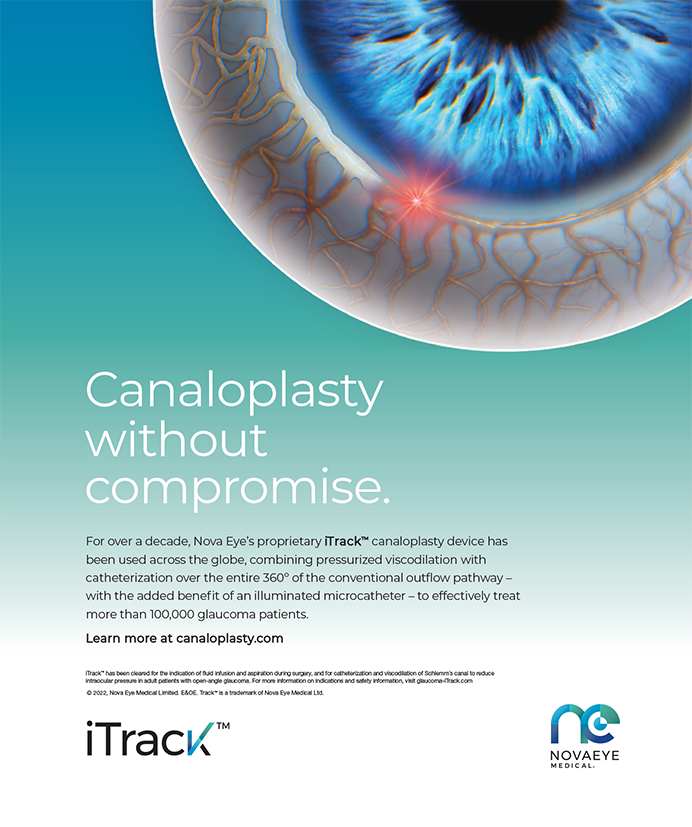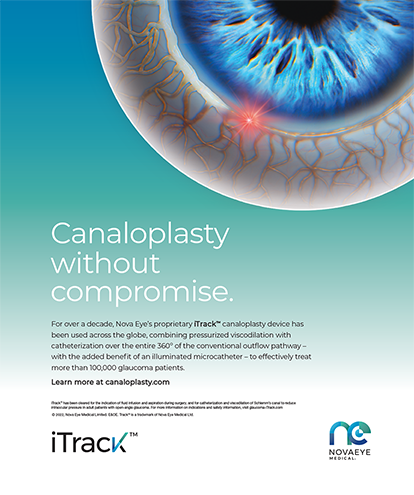

A randomized controlled trial comparing outcomes of cataract surgery in nanophthalmos with and without prophylactic sclerostomy
Rajendrababu S, Babu N, Sinha S, et al1
ABSTRACT SUMMARY
In a single-center, randomized controlled trial conducted at Aravind Eye Hospital, investigators evaluated the outcomes and complications of cataract surgery with or without prophylactic sclerostomy in nanophthalmic eyes (axial length < 20.5 mm and retinochoroidoscleral thickness > 1.7 mm) that had a visually significant cataract. A total of 60 eyes of 60 patients were randomly assigned to cataract surgery alone (control group, n = 31) or to cataract surgery and prophylactic sclerostomy (n = 29). Patients underwent phacoemulsification or manual small-incision cataract surgery (MSICS) based on cataract grade.
Fewer complications occurred in the sclerostomy group (5/29) than in the control group (12/31; P = .065). Four eyes in the control group and none in the sclerostomy group developed postoperative choroidal effusions, and five control eyes and one sclerostomy eye developed intraoperative complications. In multivariable models, a sclerostomy decreased the odds of an intra- or postoperative complication by 80% (odds ratio [OR], 0.20; 95% confidence interval [CI], 0.04–0.92; P = .039). MSICS carried a higher risk of complications compared with phacoemulsification (OR, 5.95; 95% CI, 1.49–23.73; P = .012). A preoperative IOP higher than 16 mm Hg and a lens thickness greater than 4.5 mm were marginally associated with increased complications.
The investigators concluded that performing concomitant prophylactic sclerostomy during cataract surgery in nanophthalmic eyes might reduce vision-threatening complication rates, particularly of uveal effusions.
DISCUSSION
How was the prophylactic sclerostomy performed?
One retina surgeon performed all single-quadrant prophylactic posterior sclerostomies inferotemporally (supplemental video available at bit.ly/2EAvvKy). The ophthalmologist created a superficial 4 × 4–mm partial-thickness rectangular scleral flap 10 to 12 mm posterior to the limbus, close to the vortex veins. Next, the surgeon excised a 2 × 2–mm deeper scleral block. The edges of this scleral window were cauterized to maintain patency and allow slow fluid egress. The surgeon closed the superficial scleral flap with a 7-0 polyglactin suture.
Study in Brief
The results of a single-center randomized controlled trial suggest that performing a prophylactic sclerostomy during cataract surgery in nanophthalmic eyes may reduce the rates of vision-threatening complications, particularly uveal effusions.
WHY IT MATTERS
Were there complications related to the sclerostomies?
The investigators noted no complications as a result of the sclerostomy procedure itself. Prior studies have reported complications such as retinal break, retinal detachment, fibrovascular ingrowth into the sclerostomy site, and vitreous incarceration. In this trial, there was a higher rate of fibrinous reaction in the sclerostomy group than in the control group (3 vs 1; P = .27), which was not statistically significant but might suggest greater postoperative inflammation because of the sclerostomy.
Should phacoemulsification or MSICS be performed in nanophthalmic eyes?
Complications were more frequently observed in patients undergoing MSICS. Phacoemulsification has several advantages in nanophthalmic eyes, including a smaller incision, better chamber maintenance, and controlled infusion parameters. The investigators concluded that phacoemulsification might be a better option than MSICS in patients with nanophthalmos and that it might be preferable to perform cataract extraction earlier, when phacoemulsification is a viable option.
Effect of Prostaglandin Analogue Use on the Development of Cystoid Macular Edema after Phacoemulsification using STROBE Statement Methodology
Hernstadt DJ, Husain R2
ABSTRACT SUMMARY
The researchers performed a systematic search of Medline and PubMed (1946–October 31, 2016) to determine the effect of prostaglandin analogue (PGA) use on the development of cystoid macular edema (CME) after cataract surgery. Of 412 articles, 13 met the inclusion criteria and were analyzed using Strengthening the Reporting of Observational Studies in Epidemiology (STROBE) criteria. The investigators excluded studies if NSAID prophylaxis was used, if a PGA and its association with CME were studied in settings other than in relation to cataract surgery, or if additional medication was used concurrently with the PGA to alter the effect on postoperative CME. Case reports and case series with fewer than five patients were also excluded.
Of 86,308 eyes, 4,416 were being treated with a PGA. Clinically significant CME developed in 97 eyes, and angiographic CME developed in 38. There was no association between perioperative PGA use and the development of clinically significant CME after cataract surgery at any time point. The investigators found no evidence that stopping PGAs prior to or during the course of cataract surgery reduced the incidence of CME, but they posited that eyes with multiple risk factors might be more prone to PGA-mediated CME. Larger prospective, randomized controlled studies are needed to determine the relationship between PGA use and the development of CME in complex eyes such as those with a history of prior CME, uveitis, an absent or ruptured capsule, vitreous loss during cataract surgery, or placement of an anterior chamber IOL.
Study in Brief
A systematic search of Medline and PubMed yielded no evidence that stopping prostaglandin analogues (PGAs) before or during the course of cataract surgery reduced the incidence of cystoid macular edema (CME), but eyes with multiple risk factors may be more prone to PGA-mediated CME.
WHY IT MATTERS
DISCUSSION
What is the current practice, and what did the investigators recommend based on the results of their study?
Current clinical practice varies widely. Among ophthalmologists surveyed in the United Kingdom, 59.7% did not stop PGAs for uneventful cataract surgery, 19.5% routinely stopped the drugs, and 20.8% stopped them only if other risk factors for CME were present. Conversely, in Greece, 80% of ophthalmologists surveyed discontinued PGA use perioperatively, and 65% did so routinely.
Based on this review, there is no evidence that stopping PGA use prevents the development of CME in any patient. Caution is recommended in complex eyes, however, and perhaps more so in the postoperative use of PGAs. Multiple studies included in the analysis of the postoperative use of PGAs reported the development of CME in eyes with risk factors including absent posterior capsule; previous CME; prior uveitis; anterior vitrectomy; multiple glaucoma surgeries, such as trabeculectomy, Ahmed Glaucoma Valve (New World Medical), or bleb revision; or multiple intravitreal surgeries, such as membrane peeling and vitrectomy for retained lens fragments. Among these eyes, an absent posterior capsule was seen more often, suggesting that it may be associated with a higher risk of CME development. Even in this subset of patients, however, the incidence of visually significant CME was low. The investigators recommended performing an individualized risk-benefit analysis for each patient.
Alternatives to stopping PGAs include initiating NSAIDs, as recommended by the Royal College of Ophthalmologists, or closely monitoring patients for the development of CME.
If visually significant CME develops, should the PGA be stopped? What is the prognosis for patients with postoperative CME in the setting of PGA use?
Although answering these questions was not the aim of the study, it appears that, when clinically significant CME developed after preoperative, continuous, or postoperative PGA use, all investigators stopped the PGA. Among the excluded case reports, several eyes were rechallenged with a PGA after CME resolved. In some of these eyes, CME recurred. In others, it did not, whether the eyes were rechallenged with a PGA alone or in combination with an NSAID or steroid. Causation could not be proven, given the limitations of study design and small case numbers.
In 12 of 20 cases in which CME developed after postoperative PGA use, cessation alone led to resolution of the complication. Otherwise, resolution occurred after PGA cessation combined with the topical administration of NSAIDs, steroids, or both. In studies in which PGA use was allowed preoperatively, most cases of CME resolved within 14 to 16 weeks. Among patients using a PGA continuously, the CME cleared within 1 month of their stopping the drug, along with initiation of an NSAID.
1. Rajendrababu S, Babu N, Sinha S, et al. A randomized controlled trial comparing outcomes of cataract surgery in nanophthalmos with and without prophylactic sclerostomy. Am J Ophthalmol. 2017;183:125-133.
2. Hernstadt DJ, Husain R. Effect of prostaglandin analogue use on the development of cystoid macular edema after phacoemulsification using STROBE statement methodology. J Cataract Refract Surg. 2017;43(4):564-569.




